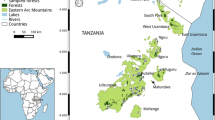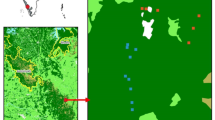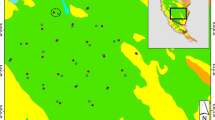Abstract
In northcentral Namibia, Waterberg Plateau Park (WPP) is a protected area that acts as a refuge for rare and endangered species, while the farmlands surrounding the Park are managed for livestock production, but support populations of wildlife for game farming, trophy hunting, and conservation. During June–October 2006, camera-traps were set within and surrounding WPP to assess leopard (Panthera pardus) density (n = 19 camera stations and 946 camera-trap-nights). Fortuitously, photographic results (2,265 photos of identifiable mammal (n = 37) and bird (n = 25) species) allowed us to assess aspects of species diversity and differences among the Park, the farmland areas along the Waterberg Plateau escarpment, and the flatlands surrounding the escarpment. Species composition among the three areas was markedly different, and made sense with respect to differences in habitat and management features. Camera-trapping efforts, although intended for a narrow purpose, may also provide a rather robust record of differences in mammal and bird diversity in adjacent habitats and can be incorporated into long-term monitoring programs.
Similar content being viewed by others
References
Azlan JM, Sharma DSK (2006) The diversity and activity patterns of wild felids in a secondary forest in Peninsular Malaysia. Oryx 40:36–41
Barnard P (1998) Biological diversity in Namibia: a country study. Namibian National Biodiversity Task Force, Windhoek
Carbone C, Christie S, Conforti K, Coulson T, Franklin N, Ginsberg JR, Griffiths M, Holden J, Kawanishi K, Kinnaird M, Laidlaw R, Lynam A, Macdonald DW, Martyn D, McDougal C, Nath L, O’Brien T, Siedensticker J, Smith JLD, Sunquist M, Tilson R, Wan Shahruddin WN (2001) The use of photographic rates to estimate densities of tigers and other cryptic mammals. Anim Conserv 4:75–79
Cheetah Conservation Fund (2005) Waterberg conservancy 24-hour waterhole count. Final Report, Otjiwarongo, Namibia
Hanssen L, Stander PE (2004) Namibia large carnivore atlas. Predator Conservation Trust, Windhoek
Hilty JA, Brooks C, Heaton E, Hilty JA, Merenlender AM (2006) Forecasting the effect of land-use change on native and non-native mammalian predator distributions. Biodivers Conserv 15:2853–2871
Jackson RM, Roe JD, Wangchuk R, Hunter DO (2006) Estimating snow leopard population abundance using photography and capture-recapture techniques. Wildl Soc Bull 34:772–781
Jankowitz WJ (1983) The major plant communities of the Waterberg Plateau Park. S Afr J Bot 2:251
Jarvis AM, Robertson A (1999) Predicting population sizes and priority conservation areas for 10 endemic Namibian bird species. Biol Conserv 88:121–131
Karanth KU (1998) Estimation of tiger densities in India using photographic captures and recaptures. Ecology 79:2852–2862
Kaufman MJ, Sanjayan M, Lowenstein J, Nelson A, Jeo RM, Crooks KR (2007) Remote camera-trap methods and analyses reveal impacts of rangeland management on Namibian carnivore communities. Oryx 41:70–78
Kingdon J (1997) The Kingdon field guide to African mammals. Academic Press, New York
Maclean GL (1993) Roberts’ birds of southern Africa, 6th edn. New Holland
Martins SD, Sanderson JG, Silva-Junior JDE (2007) Monitoring mammals in the Caxiuana National Forest, Brazil—first results from the Tropical Ecology Assessment and Monitoring (TEAM) program. Biodivers Conserv 16:857–870
Mendelsohn JM, Jarvis AM, Roberts CS, Robertson T (2002) Atlas of Namibia. Research and Information Services of Namibia, Windhoek
Mills G, Hes L (1997) The complete book of southern African mammals. Struik Publishers, Capetown
Moruzzi TL, Fuller TK, DeGraaf RM, Brooks RT, Li WJ (2002) Assessing remotely triggered cameras for surveying carnivore distribution. Wildl Soc Bull 30:380–386
Schneider I (1998) Waterberg Plateau Park Namibia. Shell Namibia, Windhoek
Sinclair I, Hockey P, Tarboton W, Hayman P, Arlott N (1995) Illustrated guide to the birds of southern Africa. Princeton University Press, Princeton
Skinner JD, Chimimba CT (2005) The mammals of the southern African subregion. University Press, Cambridge
Stein AS (2008) Ecology and conservation of the leopard (Panthera pardus Linnaeus 1758) in northcentral Namibia. Dissertation, University of Massachusetts, Amherst
Trolle M (2003) Mammal survey in the southeastern Pantanal, Brazil. Biodivers Conserv 12:823–836
Trolle M, Bissaro MC, Prado HM (2007a) Mammal survey at a ranch of the Brazilian Cerrado. Biodivers Conserv 16:1205–1211
Trolle M, Noss AJ, Lima EDS, Dalponte JC (2007b) Camera-trap studies of maned wolf density in the Cerrado and the Pantanal of Brazil. Biodivers Conserv 16:1197–1204
Acknowledgments
We would like to acknowledge the government of Namibia, specifically the Ministry of Environment and Tourism, for allowing us to conduct this research. Within the Park, the chief warden, Boas Erckie, and the anti-poaching staff lead by Thomas Shikuvi and Moses Hangula were instrumental in the implementation of the study. Vitalis Uungwama of the Park staff and Eben Tjiteere of the Polytechnic of Namibia were primary field assistants. Financial support was provided by the Wildlife Conservation Society through the Research Fellowship Program, and camera-traps were supplied by the Cheetah Conservation Fund. Logistical support was provided by the University of Massachusetts, Amherst and the Cheetah Conservation Fund and their volunteers. We thank two anonymous reviewers for very helpful comments on a draft of the manuscript.
Author information
Authors and Affiliations
Corresponding author
Rights and permissions
About this article
Cite this article
Stein, A.B., Fuller, T.K. & Marker, L.L. Opportunistic use of camera traps to assess habitat-specific mammal and bird diversity in northcentral Namibia. Biodivers Conserv 17, 3579–3587 (2008). https://doi.org/10.1007/s10531-008-9442-0
Received:
Accepted:
Published:
Issue Date:
DOI: https://doi.org/10.1007/s10531-008-9442-0




